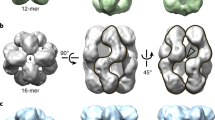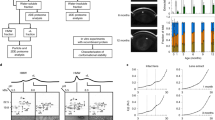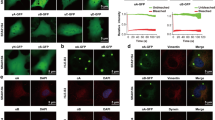Abstract
The Gram-negative bacterium Myxococcus xanthus has a complex life cycle1 during which large amounts of a protein of relative molecular mass (Mr) 19,000, known as protein S, are assembled into a spore surface coat by a process that specifically requires calcium ions2,3. The gene for protein S has been cloned and the DNA sequence shows that the gene product is composed of four internally repeated homologous sequences, each 40 amino acids long4. Although protein S resembles calmodulin both in its internally duplicated structure and its ability to bind calcium4, it apparently has a β-sheet secondary structure5 rather than the helix–loop–helix motifs that characterize the calmodulin family6–8. We now show that protein S has a striking homology with the β- and γ-crystallins of the vertebrate eye lens9–11 which are β-sheet proteins with internally duplicated structures. This implies that the β- and γ-crystallins evolved from already existing proteins, whose ancestors occurred in the prokaryotes. The biological function of protein S, as a closely packed, stable protein in a relatively dehydrated environment, has implications for the functions of crystalline, which are found closely packed in the lens fibre cells, where their stability is essential for maintenance of transparency.
This is a preview of subscription content, access via your institution
Access options
Subscribe to this journal
Receive 51 print issues and online access
$199.00 per year
only $3.90 per issue
Buy this article
- Purchase on Springer Link
- Instant access to full article PDF
Prices may be subject to local taxes which are calculated during checkout
Similar content being viewed by others
References
Kaiser, D., Manoil, C. & Dworken, M. A. Rev. Microbiol. 33, 595–639 (1979).
Inouye, M., Inouye, S. & Zusman, D. R. Devl Biol. 68, 579–591 (1979).
Inouye, M., Inouye, S. & Zusman, D. R. Proc. natn. Acad. Sci. U.S.A. 76, 209–213 (1979).
Inouye, S., Franceschini, T. & Inouye, M. Proc. natn. Acad. Sci. U.S.A. 80, 6829–6833 (1983).
Inouye, S., Harada, W., Zusman, D. & Inouye, M. J. Bact. 148, 678–683 (1981).
Kretsinger, R. H. & Nockolds, C. E. J. biol. Chem. 248, 3313–3326 (1973).
Szebenyi, D. M. E., Obendorf, S. K. & Moffat, K. Nature 294, 327–332 (1981).
Kretsinger, R. H. CRC crit. Rev. Biochem. 8, 119–174 (1980).
Blundell, T. L. et al. Nature 289, 771–7777 (1981).
Wistow, G. et al. J. molec. Biol. 170, 173–202 (1983).
Summers, L. et al. Peptide and Protein Reviews Vol. 3 (ed. Hearn, M. T. W.) 147–168 (Dekker, New York, 1984).
Bhat, S. P. & Spector, A. DNA 3, 287–296 (1984).
Moormann, R. J. M., Den Dunnen, J. T., Bloemendal, H. & Schoenmakers, J. G. G. Proc. natn. Acad. Sci. U.S.A. 79, 6876–6880 (1982).
Tomarev, S. F., Krayev, A. S., Skryabin, K. G., Gause, G. G. & Bayev, A. A. Dokl. Akad. Nauk SSSR 263, 1489–1492 (1982).
Tomarev, S. F., Krayev, A. S., Skryabin, K. G., Bayev, A. & Gause, G. G. FEBS Lett. 146, 315–318 (1982).
Lok, S. et al. Nucleic Acids Res. 12, 4517–4529 (1984).
Driessen, H. P. C., Herbrink, P., Bloemendal, H. & de Jong, W. W. FEBS Lett. 161, 225–229 (1981).
Inana, G., Piatigorsky, J., Norman, B., Slingsby, C. & Blundell, T. L. Nature 302, 310–315 (1983).
Schoenmakers, J. G. G. et al. Ciba Fdn Symp. 106, 208–218 (1984).
Lesk, A. & Chothia, C. J. molec. Biol. 160, 325–342 (1982).
Inouye, S., Inouye, M., McKeever, B. & Sarma, R. J. biol. Chem. 255, 3713–3714 (1980).
Inouye, S., Ike, Y. & Inouye, M. J. biol. Chem. 258, 38–40 (1983).
Giblin, F. J., Hightower, K. R., Ragatzki, P. A. & Readdy, V. N. Expl Eye Res. 39, 9–17 (1984).
Harding, J. J. & Dilley, K. J. Expl Eye Res. 22, 1–73 (1976).
Jones, T. A. J. appl. Crystallogr. 11, 268–272 (1978).
Wistow, G. et al. FEBS Lett. 133, 9–16 (1981).
Author information
Authors and Affiliations
Rights and permissions
About this article
Cite this article
Wistow, G., Summers, L. & Blundell, T. Myxococcus xanthus spore coat protein S may have a similar structure to vertebrate lens βγ-crystallins. Nature 315, 771–773 (1985). https://doi.org/10.1038/315771a0
Received:
Accepted:
Published:
Issue Date:
DOI: https://doi.org/10.1038/315771a0
This article is cited by
-
Explosive Expansion of βγ-Crystallin Genes in the Ancestral Vertebrate
Journal of Molecular Evolution (2010)
-
Vertebrate-like ??-crystallins in the ocular lenses of a copepod
Journal of Comparative Physiology A (2005)
-
An eye on crystallins
Nature Structural Biology (1997)
-
The structure of avian eye lens δ-crystallin reveals a new fold for a superfamily of oligomeric enzymes
Nature Structural & Molecular Biology (1994)
-
Conformational studies on δ-crystallin, the core protein of the bird eye lens
Proceedings / Indian Academy of Sciences (1994)
Comments
By submitting a comment you agree to abide by our Terms and Community Guidelines. If you find something abusive or that does not comply with our terms or guidelines please flag it as inappropriate.



